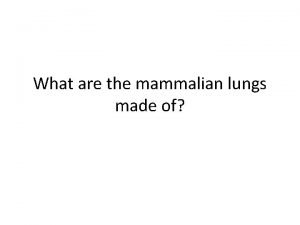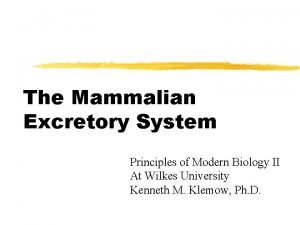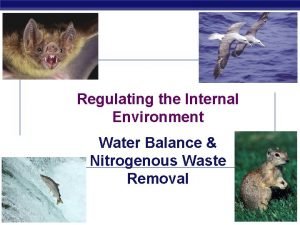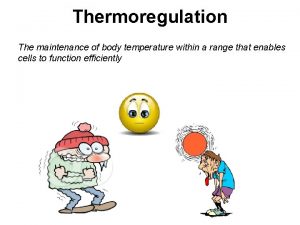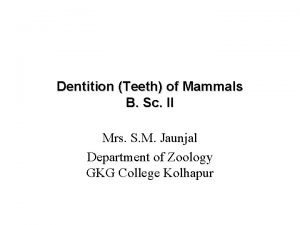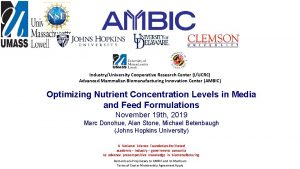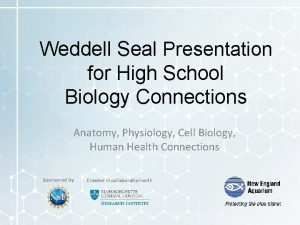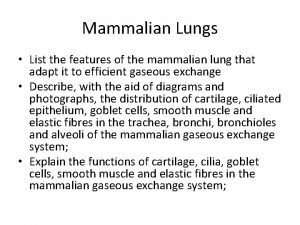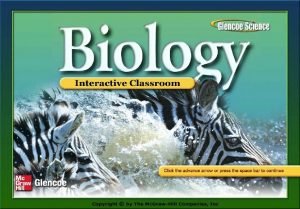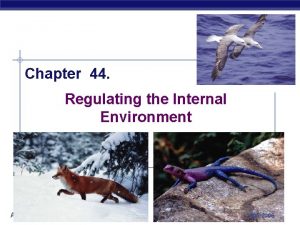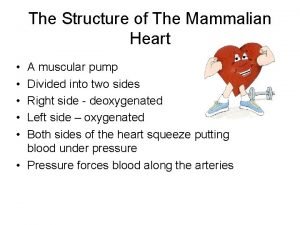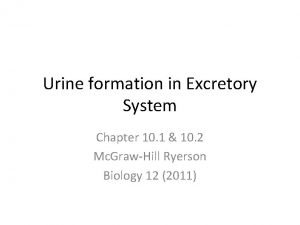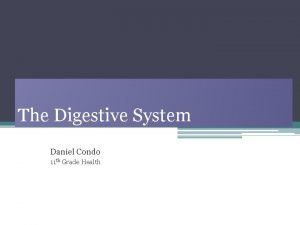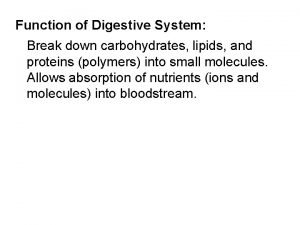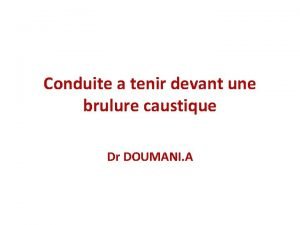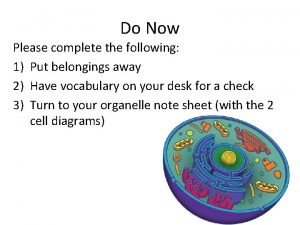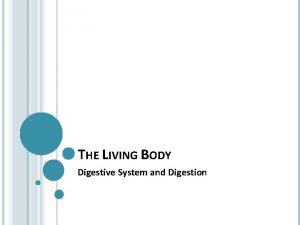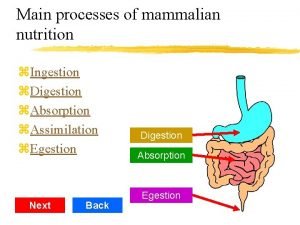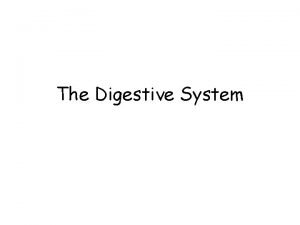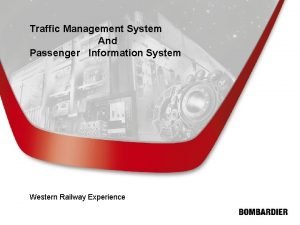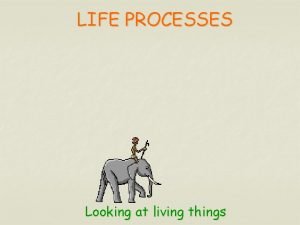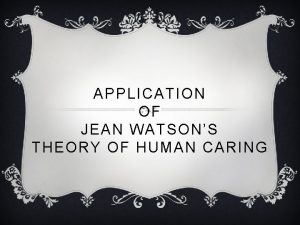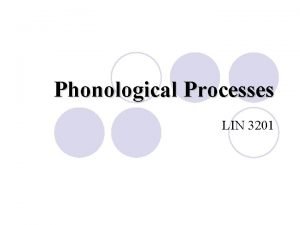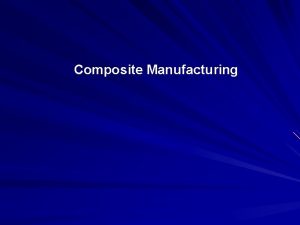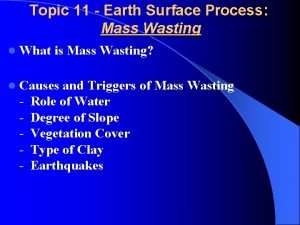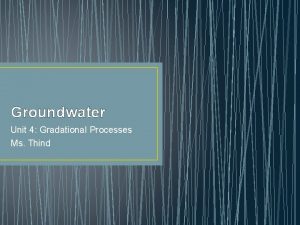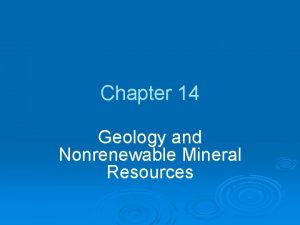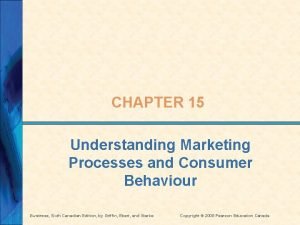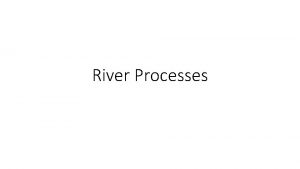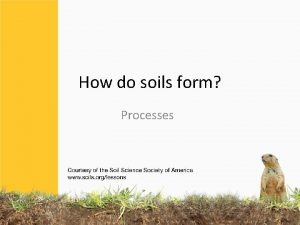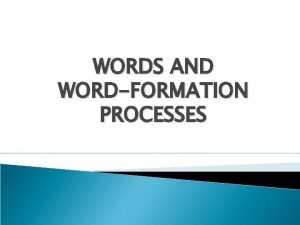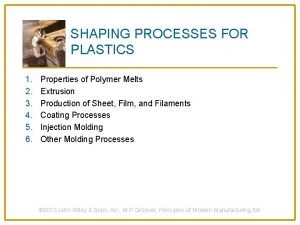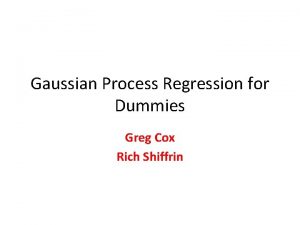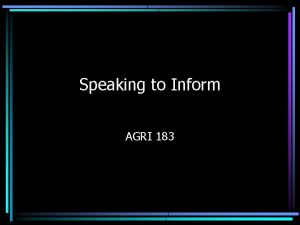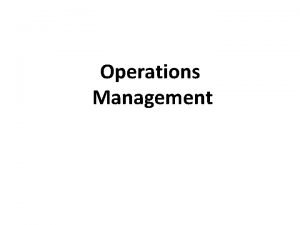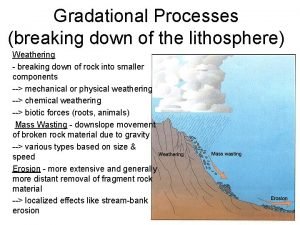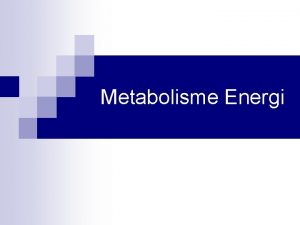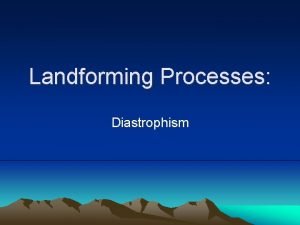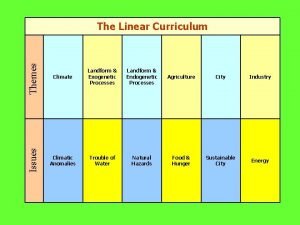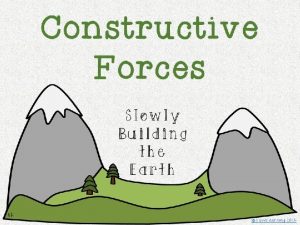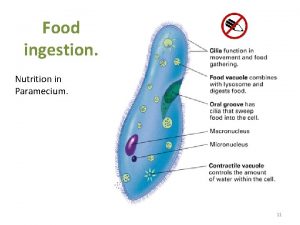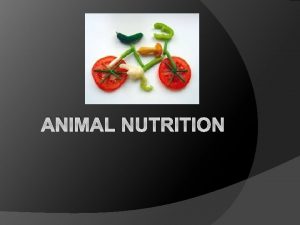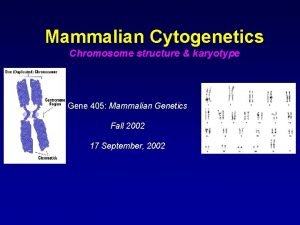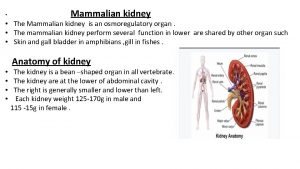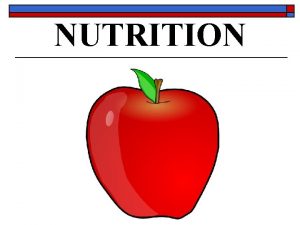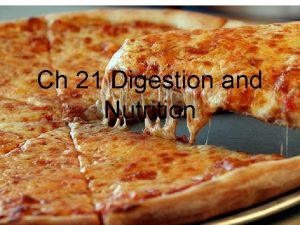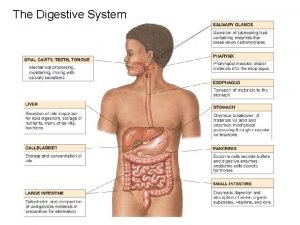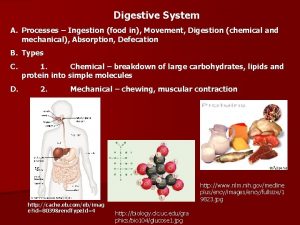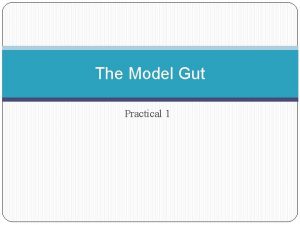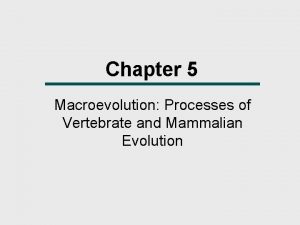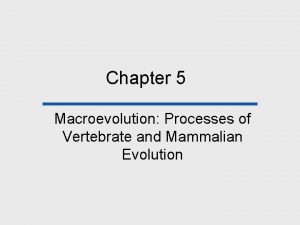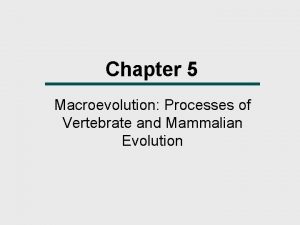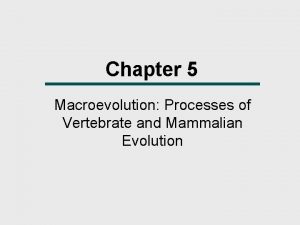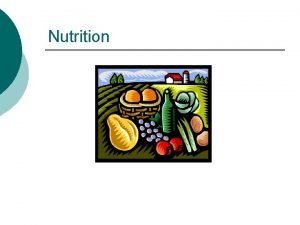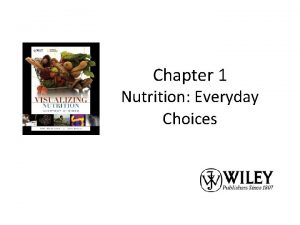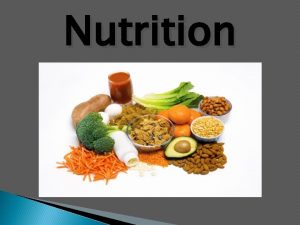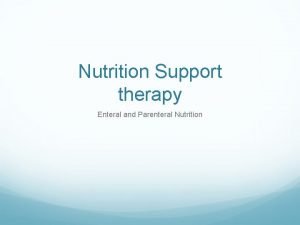Main processes of mammalian nutrition z Ingestion z



























































- Slides: 59

Main processes of mammalian nutrition z. Ingestion z. Digestion z. Absorption z. Assimilation z. Egestion Next Back Digestion Absorption Egestion

Main processes of mammalian nutrition z. Ingestion z. Digestion z. Absorption z. Assimilation z. Egestion Next Back Digestion Absorption Egestion

Ingestion zis the intake of food into the alimentary canal zrelevant organs: yteeth zrelevant processes: yswallowing yperistalsis Next Back

Ingestion II zis the intake of food into the alimentary canal zrelevant organs: yteeth premolar incisor canine molar zrelevant processes: yswallowing yperistalsis Next Back

Digestion zis the breaking down of food into molecules small enough to be absorbed into the body zrelevant organs ymouth and teeth yalimentary canal ystomach yduodenum Next Back

Absorption zis the movement of digested, soluble and simple molecules from the gut through the wall into the body (Cont’d) zrelevant processes ydiffusion yactive transport zrelevant structures Next Back

Assimilation zis the uptake & utilisation of absorbed food molecules by all body cells zfate of the absorbed food yglucose energy production yamino acids building up body materials yfats energy reserve zroles of liver in assimilation Next Back

Egestion zis the removal of undigested and unwanted food materials from the alimentary canal zrelevant structures zabnormal cases: ydiarrhoea yconstipation Next Back

Egestion II zis the removal of undigested and unwanted food materials from the alimentary canal zrelevant structures zabnormal cases: ydiarrhoea yconstipation Next Back

Teeth zstructure of a tooth yenamel ydentine ypulp cavity Enamel Crown Dentine Neck Pulp Cavity Root Cement ztype zdentition Next Back Jaw Bone Nerve & blood vessel

Teeth II zstructure of a tooth yenamel ydentine ypulp cavity Enamel Crown Dentine Neck Pulp Cavity Root Cement ztype zdentition Next Back Jaw Bone Nerve & blood vessel

Enamel zoutermost znon-living zhardest layer zmade up of ycalcium phosphate ycalcium fluoride yorganic matter Next Back

Dentine zmiddle layer zhard, bone like (softer than enamel) Next Back

Pulp Cavity zinnermost layer zliving cells, blood vessels and nerve zblood vessels: oxygen and nutrient znerves: sensitive to stimuli ytemperature ypressure Next Back

Type of Teeth Next Back

Dentition zdental formula of a human ytype of teeth premolar incisor canine molar yon one side only yupper jaw ylower jaw ymilk teeth: 2120 permanent teeth: 2123 20 2120 Next Back 32 2123

Tooth Decay zcaused by the chemical actions of bacteria in plaque zplaque is a sticky, invisible film on the teeth surface zbacteria turns sugars into acids zacids dissolve the enamel and dentine Next Back

Tooth Decay zcaused by the chemical actions of bacteria in plaque zplaque is a sticky, invisible film on the teeth surface zbacteria turns sugars into acids zacids dissolve the enamel and dentine zirritation on the nerve, cause toothache Next Back

How to prevent tooth decay zgood brushing habits zusing appropriate cleaning materials zavoiding sugary food zhaving a balanced diet zhaving regular dental check-up Next Back

Alimentary Canal za tube from mouth to anus zis modified into different structures zdigestive system = alimentary canal alimentary + associated glands Next Back

Alimentary Canal za tube from mouth to anus zis modified into different structures zdigestive system = alimentary canal alimentary + associated glands zsequence of the structures oesophagus duodenum appendix stomach caecum rectum ileum colon anus Next Back Intestinal Pancreas Salivary Gastric Liver gland

Swallowing ztongue raises pushing the bolus to the back zbolus pushes the soft palate upwards zepiglottis lowers and covers the trachea zbolus enters the oesophagus Next Back

Swallowing-Movie

Peristalsis zfood is moved along the canal by zrhythmic contraction and relaxation of two muscles ycircular muscle ylongitudinal muscle zdemonstration Next Back Peristalsis Oesophagus

Digestion II zonly small molecules can pass through the wall of intestine zfood are usually composed of large molecules zfood should be digested before absorption zphysical methods zchemical methods Next Back

Physical Digestion z. Teeth z. Stomach z. Bile salt Next zby churning zby emulsifying action in duodenum z by grinding chewing tearing cutting biting Back

Chemical Digestion zinvolved the change of the chemical structures of food amylase maltose ze. g. Starch maltose zthis involves digestive enzymes zno digestion on: water, glucose, simple sugars, minerals, vitamins Next Back

Chemical digestion by Amylase z Chemical break-up of starch molecules into maltose molecules by amylase.

Mouth zsaliva is a digestive juice consisting of yamylase ymucus ywater zit is slightly alkaline Next Back

Stomach zcardiac sphincter zaction of proteases protease zaction of hydrochloric acid yprovide acidic medium for proteases zpyloric sphincter Next Back

Mechanical digestion in Stomach z Squeezing actions of stomach. Churning- breaking down the partly digested food into smaller pieces.

Duodenum zpancreatic juice yamylase, proteases, lipases zbile ycolour, composition, no enzymatic property zintestinal juice ycarbohydrases, proteases Next Back

Pancreatic Amylase Starch Next Maltose Back

Bile - with bile salts produced in liver - stored in gall bladder - action in small intestine Liver Gall Bladder Small Intestine Next Back

Bile -contain bile salts which emulsify lipids into small droplets without chemical change. Next Back

Digestion and Absorption of Fats Next Back

Ileum - Intestinal Juice produced and action in small intestine Next Back

Intestinal Juice - Contain enzymes of 2 categories: 1. Carbohydrase 2. Protease Next Back

Intestinal Carbohydrases double sugars Next Back simple sugars

Intestinal Proteases Peptides Next Amino acids Back

Completion of Digestion is completed by the end of the long small intestine Next Back

Caecum, Colon & Rectum zno enzyme secretion in omnivores and carnivores zspecific function in herbivores ymicro-organisms ycellulase yweakness Next Back

Absorption II ztake place in ileum zstarts at stomach / duodenum zvillus Next Back

Villus zfinger like projections yincrease S. A. /V zone cell thick zmany blood vessels zcentral lacteal Next Back villus Blood vessels lacteal epithelium

Transport of absorbed food Water Fat solublefood lumen epithelium blood capillaries lacteal hepatic vein liver vena cava hepatic portal veinvessel Lymph vena cava heart (general circulation) Next Back

Assimilation II zfate of absorbed food substances yglucose yamino acids yfats zroles of liver Next Back

Fate of glucose zfor releasing energy zexcess glucose will be stored as yglycogen yfats zstorage site yliver ymuscle Next Back

Fate of amino acids zfor making new cells and tissues zexcess amino acids will be deaminated zproduct: urea zsite of excretion: ykidney Next Back

Fate of fats zfor formation of cell membranes zexcess fats will be stored yfats zstorage site yadipose tissue Next Back

Roles of liver zregulating blood glucose level zstoring glycogen zstoring iron and vitamins zbreaking down excess amino acids Next Back

Diarrhoea z. Causes: y(1) bacterial infection y(2) eating poisonous substances z. Consequences: y(1) quick movement of intestine y(2) food passes along the canal quickly y(3) less water absorbed y(4) watery faeces produced Next Back

Constipation z. Causes: yeating too less dietary fibres yeating too less fresh fruit z. Consequences: y(1) slow movement of intestine y(2) food passes along the canal slowly y(3) much water absorbed y(4) hard, dried faeces produced Next Back

Glossary z Active transport: movement of molecules against concentration gradient with the utilizing of energy. z Amylase: an enzyme that convert starch to maltose. z Carbohydrases: enzymes digest carbohydrates into simpler molecules. Eg. Intestinal Carbohydrases z Carnivores: organisms feed on animals only z Diffusion: movement of molecules from a region of high concentration to a region of low concentration z Herbivores: organisms feed on plants only z Lipases: enzymes digest fat/oil into simpler molecules

Glossary z Mucus: a sticky substance secreted by epithelial cells of the gut z Omnivores: organisms feed on animals and plants z Proteases: enzymes digest protein into simpler molecules

Pancreatic Proteases Protein Peptides Intestinal digestion

Pancreatic Lipases Lipids Glycerol + 3 Fatty Acids Intestinal digestion

Intestinal Carbohydrases double sugars simple sugars Intestinal digestion

Intestinal Proteases Peptides Amino acids Intestinal digestion

THE END
 Concurrent processes are processes that
Concurrent processes are processes that Epithelium of trachea
Epithelium of trachea The mammalian excretory system
The mammalian excretory system Mammalian excretory system
Mammalian excretory system Diving reflex
Diving reflex Dentition in mammal
Dentition in mammal Mammalian biomanufacturing
Mammalian biomanufacturing Mammalian dive reflex
Mammalian dive reflex Mammalian lung diagram
Mammalian lung diagram Chapter 30 section 1 mammalian characteristics answer key
Chapter 30 section 1 mammalian characteristics answer key Mammalian excretory system
Mammalian excretory system Labelled diagram of heart
Labelled diagram of heart Mammalian excretory system
Mammalian excretory system Ingestion y digestion
Ingestion y digestion Digestive system function quiz
Digestive system function quiz What is the function of anus
What is the function of anus Process of ingestion
Process of ingestion Classification de di costanzo
Classification de di costanzo Cell wall function
Cell wall function Ingestion and digestion
Ingestion and digestion Chapter 7:11 digestive system
Chapter 7:11 digestive system Ingestion body parts
Ingestion body parts Pic of digestive system
Pic of digestive system Eap data lake
Eap data lake Ingestion digestion absorption assimilation egestion order
Ingestion digestion absorption assimilation egestion order Peristalsis vs segmentation
Peristalsis vs segmentation Disposerx ingestion
Disposerx ingestion Passenger management system
Passenger management system Tells more about the main idea
Tells more about the main idea Void main int main
Void main int main Be going to form
Be going to form Life process
Life process 10 caritas processes examples
10 caritas processes examples Defect
Defect Phonological processes
Phonological processes Decision domain disagreements
Decision domain disagreements Chapter 15 scalp care, shampooing, and conditioning
Chapter 15 scalp care, shampooing, and conditioning Advantages and disadvantages of thermoplastics
Advantages and disadvantages of thermoplastics Examples of mass movement
Examples of mass movement Gradational processes
Gradational processes Geological processes
Geological processes Marketing processes and consumer behavior
Marketing processes and consumer behavior Communication integration processes
Communication integration processes River processes
River processes 4 soil forming processes
4 soil forming processes Word formation examples
Word formation examples Shaping processes for plastics
Shaping processes for plastics Gaussian process for dummies
Gaussian process for dummies Exceptional event itil
Exceptional event itil Speeches about objects
Speeches about objects Concasse cut size in mm
Concasse cut size in mm Coinage word formation examples
Coinage word formation examples Inputs outputs transformation processes and feedback
Inputs outputs transformation processes and feedback Gradational forces examples
Gradational forces examples Basic life processes
Basic life processes Diastrophism definition
Diastrophism definition Exogenetic processes part 2
Exogenetic processes part 2 Hot working of metal is
Hot working of metal is 7 types of jaycustomers
7 types of jaycustomers Constructive processes
Constructive processes

